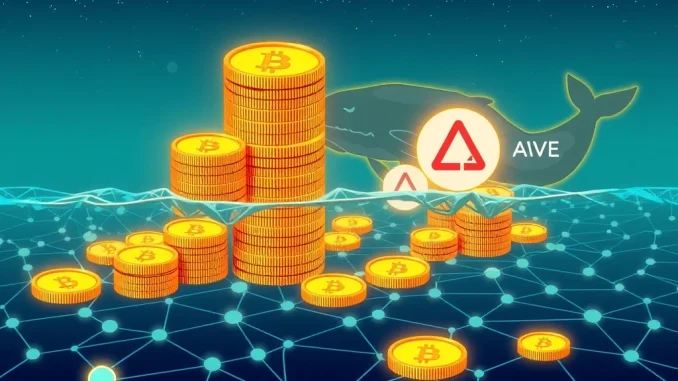
Crypto markets are buzzing following a significant on-chain movement. Tracking service Whale Alert recently flagged a massive USDT transfer, sending ripples through the community. This isn’t just any transfer; we’re talking about a staggering 300,000,000 USDT, valued at approximately $300 million, relocating from the HTX exchange to the Aave DeFi protocol. Such large movements by a crypto whale often spark speculation about market intentions and potential impacts.
What Exactly Happened in This HTX Aave Transfer?
The core of the news is straightforward: a single, colossal transaction moved 300 million units of Tether (USDT) from a wallet associated with the HTX cryptocurrency exchange to an address linked to the Aave decentralized finance platform. The sheer scale of this movement is what makes it noteworthy. For context, $300 million represents a substantial sum in the crypto world, capable of influencing liquidity and sentiment, especially when involving key platforms like a major exchange and a leading DeFi protocol.
Here are the key details reported by Whale Alert:
- Amount: 300,000,000 USDT
- Source: HTX Exchange
- Destination: Aave Protocol
- Approximate Value: $300,000,000 USD
- Reporting Entity: Whale Alert
This event highlights the transparency of public blockchains, where even multi-million dollar transactions are recorded and trackable by services like Whale Alert.
Why Would a Crypto Whale Move 300M USDT to Aave?
This is where the speculation begins. Moving such a large sum from a centralized exchange (HTX) to a decentralized lending protocol (Aave) suggests a specific strategic intent. While we can’t know the exact reasons behind the HTX Aave movement, several possibilities are commonly considered when a crypto whale makes such a move:
Is the Whale Seeking Yield on Aave?
Aave is one of the largest and most popular decentralized lending and borrowing protocols. Users can deposit assets like USDT to earn interest (yield) or use them as collateral to borrow other assets. Depositing 300 million USDT could allow the owner to earn significant passive income based on Aave’s current lending rates for USDT. This is a common strategy for large stablecoin holders looking to maximize returns outside of traditional banking or centralized exchange offerings.
Could This Be Related to a Borrowing Strategy?
Alternatively, the 300 million USDT could be intended as collateral. By depositing such a large amount, the whale could potentially borrow other cryptocurrencies (like ETH, BTC, or other stablecoins) from Aave. This could be for various reasons, such as:
- Leveraging their position without selling their USDT.
- Gaining exposure to other assets.
- Funding operations or investments elsewhere in the DeFi Aave ecosystem or beyond.
Borrowing against stablecoin collateral is a key function of protocols like Aave.
Is This an Institutional Move?
While it’s impossible to confirm the identity of the whale, transactions of this size are often associated with institutions, large funds, or very wealthy individuals. Such entities may have complex strategies involving both centralized exchanges (like HTX for onboarding/offboarding) and decentralized protocols (like Aave for yield or borrowing). The move could be part of a larger portfolio management or risk diversification strategy.
Understanding the Platforms: HTX and Aave
To fully appreciate the significance of this USDT transfer, it helps to understand the entities involved:
- HTX: Formerly known as Huobi, HTX is a major centralized cryptocurrency exchange. Exchanges are typically where users buy, sell, and trade cryptocurrencies, as well as often store them. Moving funds *from* an exchange often means the user intends to do something with the assets off the primary trading platform.
- Aave: Aave is a leading decentralized finance (DeFi) protocol operating on various blockchains (like Ethereum, Polygon, etc.). It allows users to lend and borrow cryptocurrencies without intermediaries. Assets deposited into Aave’s liquidity pools are used to facilitate borrowing, and lenders earn a yield from the interest paid by borrowers. This DeFi Aave interaction is permissionless and governed by smart contracts.
Potential Implications of the Massive USDT Transfer
While a single transaction doesn’t dictate the entire market, a 300 million USDT transfer is large enough to warrant attention. What could it mean?
- Increased Liquidity on Aave: A deposit of this size significantly boosts the available liquidity for borrowing USDT on Aave, potentially impacting borrowing rates.
- Potential Market Signal: Some interpret large whale moves as potential signals. Moving stablecoins to DeFi might suggest an intention to participate in yield farming or leverage strategies rather than direct selling on an exchange.
- Focus on DeFi: This move underscores the continued importance and utility of DeFi protocols like Aave for large capital holders seeking alternatives to centralized services.
It’s crucial to remember that on-chain data shows the movement but not the precise intention. The whale could be preparing for multiple different strategies within the DeFi Aave ecosystem.
Staying Informed: Following Crypto Whale Activity
How can you keep track of these significant movements? Services like Whale Alert are invaluable for monitoring large transactions across various blockchains. Following their reports, combined with understanding the destinations (like exchanges, DeFi protocols, or unknown wallets), can provide insights into potential large-scale market participant behavior. However, always analyze such data with caution, as correlation does not equal causation.
Conclusion: A $300 Million Question Mark
The movement of 300 million USDT from HTX to Aave, flagged by Whale Alert, is a prime example of significant crypto whale activity that captures the market’s attention. This USDT transfer highlights the massive amounts of capital flowing within the digital asset ecosystem and the strategic decisions made by large holders. Whether this whale intends to earn yield, borrow assets, or pursue another strategy within DeFi Aave remains to be seen, but the transaction itself underscores the growing interplay between centralized platforms and decentralized protocols. Keeping an eye on such large on-chain movements provides a fascinating glimpse into the strategies of crypto’s biggest players.



